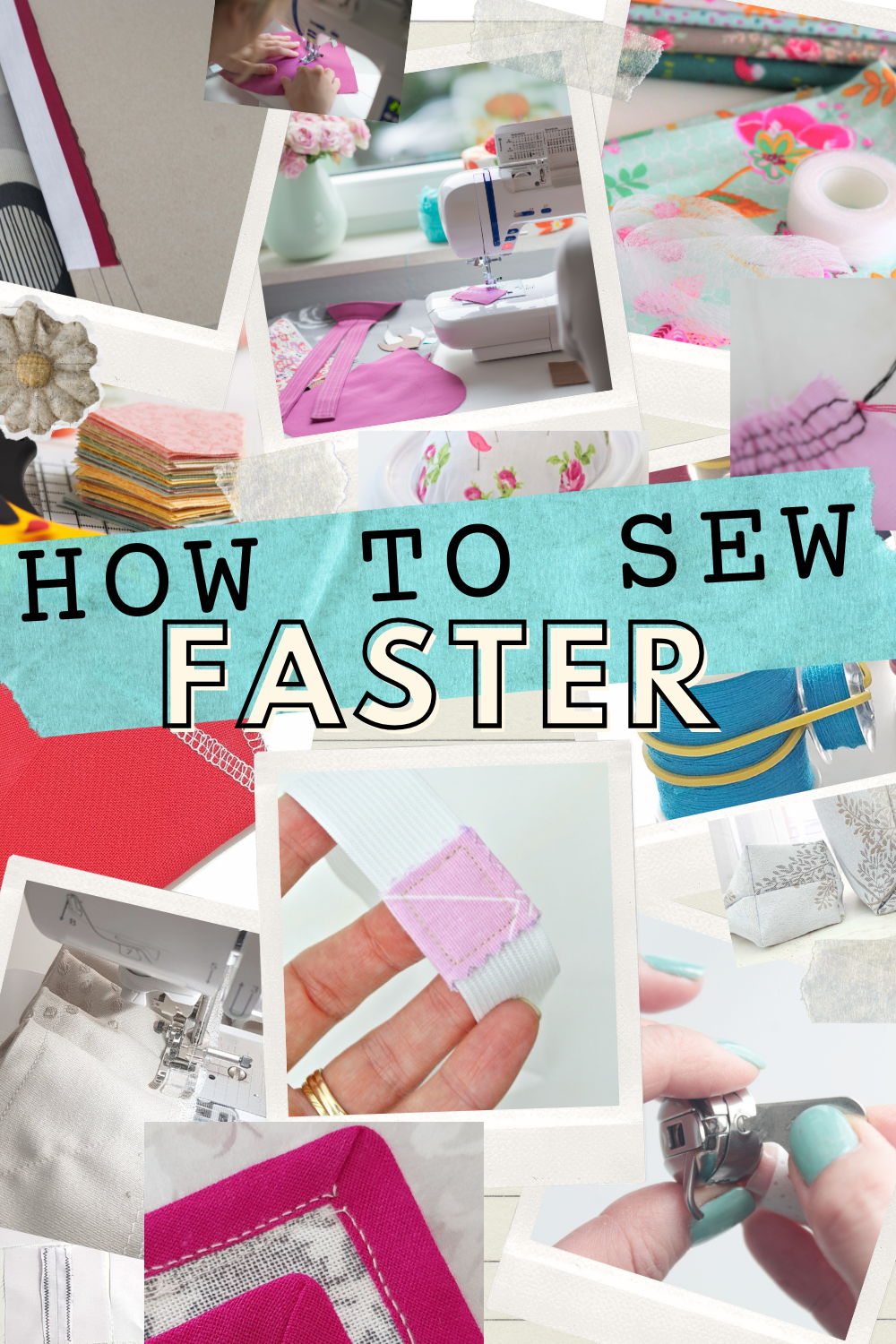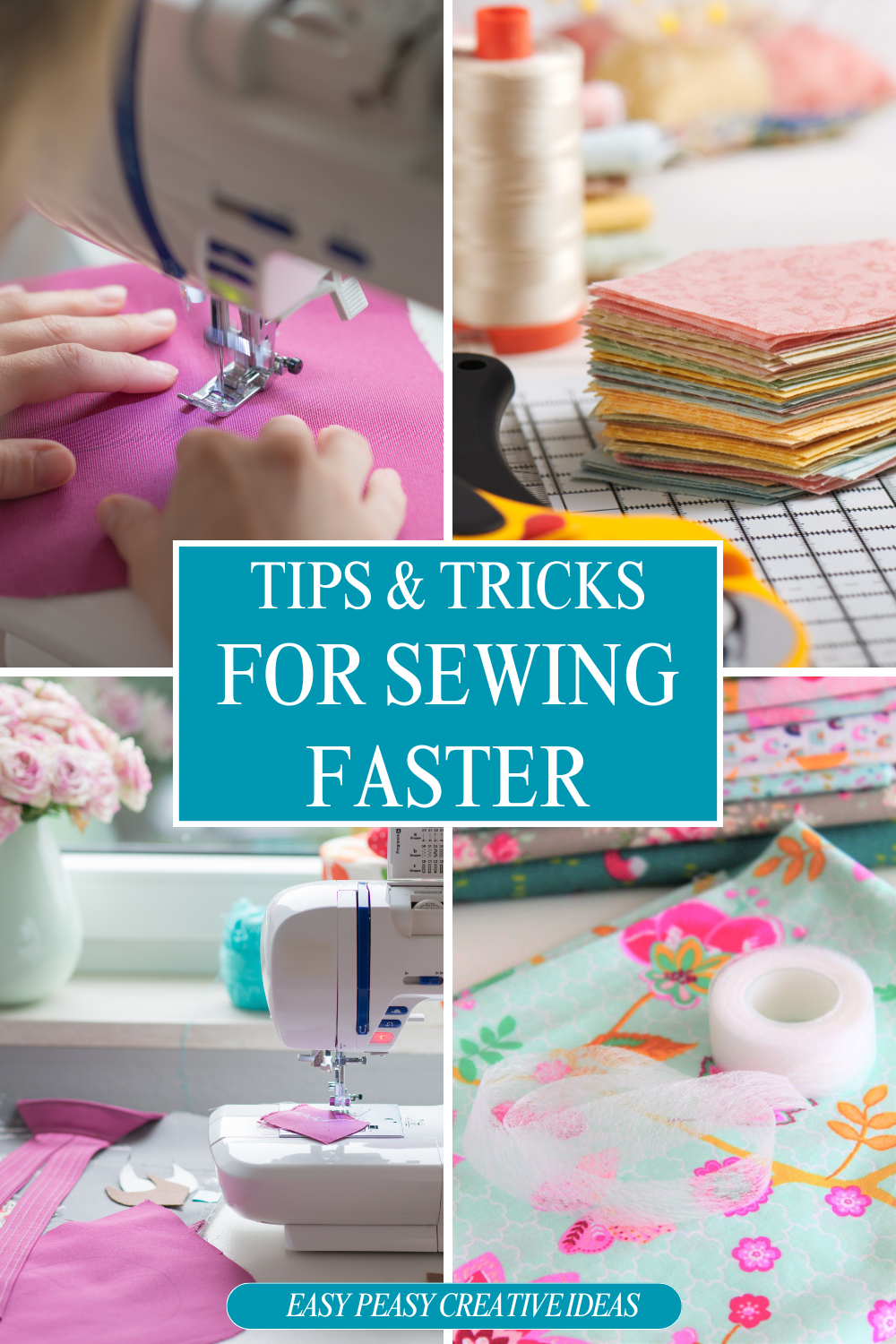How to sew faster tips and tricks
If you’re struggling with time to dedicate to your sewing passion and you’re looking for ideas to sew faster, check out this great list of tips and tricks for fast sew! These are some handy tips you need to have in your sewing arsenal, whether you’re an experienced seamstress or a beginner just starting out!

After sewing for a few good years, I’ve learned a few tips and tricks that I want to share with you today, to help you sew faster and more efficiently while getting the same professional results we all want in our projects! I started to use these tips for fast sewing regularly in the last few months and I believe I’ve gotten a lot more productive.
I’m a pretty organized person but in the past year or so something strange happened to my brain and I just couldn’t function normally (it’s probably age lol). So I’ve been more of a mess in my sewing room, taking ages to finish projects that would normally take a couple of hours at most and being real clumsy. I realized I really need to sew fast or just resort to quick sew projects which is not always easy.
One day I’ve set aside a couple of hours to figure out what I’m doing wrong and what can be improved to sew faster and to my surprise, I found that there was a lot of room for improvement! And once I started to implement these tips, my sewing time for the past few months has reduced dramatically. So here’s how to sew faster and still enjoy your favorite hobby!
Sew faster tips and tricks

Get organized
- If you haven’t done it to this point, get your sewing room organized asap! And I mean super organized! Know exactly where everything is and try and keep the most used sewing supplies in hand reach distance. Not having to get up and walk up and down the room, frantically looking for stuff you have no idea where you stashed, will save you TONS of time! Believe me, this was my major issue and once I got it figured out, my time spent sewing improved dramatically! I’ll share my sewing room settings soon and you’ll see what I’m talking about. The little white cabinet in the image above was a huge helper, I’m keeping it right under my sewing desk.
- Tightly related to the above tip is keeping movement between tasks to a minimum. For example, keep your sewing table and pressing table next to each other; keep your sewing machine and serger close to each other or use a rolling chair to move faster between these two.
- Organize all your fabrics, patterns, interfacing and supplies the day before and keep them close to your sewing table.
- Keep all your sewing tools in top shape: sharpen scissors and needles, replace worn out rotary blades etc Cutting with damaged scissors or rotary cutters will slow you down, it ruins the fabric and is pretty annoying too.
- Clean and oil your sewing machine as often as possible and never start a project on a super dirty machine. It makes things sewing more difficult and things might break inside your machine
Think about the fabric
- Try and stick with easy to sew fabrics like linen and cotton and if you must sew something flowy use silk rather than chiffon (I found silk way easier to sew, it doesn’t unravel as badly and to be honest I love how it feels and looks on the body, pretty flattering for any figure).
- Use fabrics with simple and easy to use patterns or no pattern at all if possible. This will make assembling the pieces a lot easier, helping you to sew faster in the following stages.
Group steps together
- Try and sew more projects in one go! Group similar projects into a single session rather than spread apart over a few days. Often times, it takes just a little longer to sew similar projects in one go than to sew just one item. For example, sew several t-shirts in one day or 2-3 dresses for girls etc using the same or similar fabric (like knits for t-shirts, cotton for dresses etc). It will save lots of time because you won’t have to change machine setting, thread, needle or feet. If you can use the same pattern for all items it saves even more time.
- Cut similar items at the same time. Whenever I can, I lay all the fabrics on the table or the floor (usually about 3-4 different fabrics) and tape the ends to the table and to each other, to keep them stable. I draw the pattern and cut through all the layers.
- Use a rotary cutter to cut quicker. If you have a large cutting mat, this step corroborated with the above one will save you tons of time!
- Do all similar operations at the same time: cutting patterns, cutting fabric, cutting interfacing, pinning, basting, pressing etc
Prepare in advance
- If your projects require bias tape, make your own or get the right amount ready in advanced. You can make your bias with a bias maker or without a bias maker, both options are pretty fast.
- Skip pins whenever possible! This is extremely easy with woven fabrics but you may find it almost impossible with sheer, slippery fabrics. If you can’t skip pinning, use clips instead; they’re easier and faster to attach and remove.
- Try and use threads that are a good match for all your fabrics. For example, beige or creme work well on most light colored fabrics while brown and navy work well for most dark colored fabrics.
- Instead of using small spools of thread try using cones. A cone will last a lot longer so you won’t have to waste time changing the spools, most likely for the duration of all your sewing session and some more (unless you’re sewing for an army lol).
- Get a lot of bobbins prepared in advance. Wind at least 3-4 bobbins for each project you plan on making the day before. So if you plan on sewing 3 items, get about 12 bobbins ready. Because you’re using thread that is a good match for most projects, even if you don’t use them all in this session, you’ll be able to make use of them in your next projects so no thread is wasted.
Use the right tools
- Invest in a serger and finish seams with a serger instead of resorting to other finishing techniques. You’ll spend at least half the time when serging. Do all serging at the same time if you can, for all projects.
- If you can’t afford a serger yet, use pinking shears to finish seams. It’s the next best option when it comes to saving time on finishing seams.
- Use appropriate needles and feet for your sewing projects. They make sewing easier, prevent the thread from breaking or tangling and protect the fabric from getting damaged. Check out this sewing needle chart to get a better idea of what you need and here are the feet I use regularly in addition to a regular universal foot.
I own a lot more but these are my most used sewing feet:
- roller foot – I use it for knits and thick fabrics as it helps the fabric to pass under the foot smoothly.
- ruffler foot – makes such nice, even pleats and ruffles in just the fraction of the time spent on doing them manually or the old fashion way.
- teflon foot – also known as the nonstick foot; I used it to sew leather and vinyl, it helps the fabric slide easy without sticking to the bottom of the foot.
- rolled hem foot – it makes beautiful, tiny rolled hems for lightweight fabrics.
- zipper foot – I have the regular zipper foot and the vertical zipper foot and I use both to sew regular and invisible zippers which otherwise won’t fit under a regular foot.
- buttonhole foot – it creates holes for buttons in such an easy and neat manner like I illustrated in this tutorial.
- edge stitch foot – helps me sew perfectly straight topstitching
- seam guide foot – as the name suggests, it help you keep the same seam allowance throughout the project.
Make use of the little tricks
- If you’re an experienced sewist, minimize seam allowances. This will save time as you don’t have to trim, clip and notch allowances. For example if your pattern calls for a 5/8″ allowance, make it 3/8″ instead.
- Increase the stitch length a little. For example if you normally sew with a stitch of 2, increase it to 3. But keep in mind that the length of a stitch determines its durability so if you need a seam to be real strong, like for bags or home projects, keep the stitch length short.
- Trim all threads at the same time, after you’ve finished sewing all projects.
- Figure out if you really need to backstitch at start and end. In most garments, the seams “interlock” or are “locked” by the hem so you won’t need to backsticth at all. This is particularly helpful for lightweight fabrics where backstitching might be hard to perform anyways (sometimes the fabric gets caught in the feed dogs, causing you to stop to remove it, unpick the thread and start over again).
- Whenever possible, replace zippers with buttons, snaps or velcro. All these take less time to add tto a sewing project than a zipper does. Invisible zippers take even more time so try and stay away from those if you can.
Sew like a pro
- Try and sew continuously whenever possible by pivoting the fabric at corners or chaining the items together. To do the chaining method, start with the first item to be sewn together and then keep feeding in items one after the other, sewing them together and creating a chain (much like I did with this hearts garland tutorial). This method helps with saving time and thread.
- Sewing loose fit garments rather than tight ones will save you time as you don’t have to try the garments on to check if they fit. This is particularly helpful for me when I sew dresses for my daughter as she’s either not round or too restless to stand still, making the fitting process difficult and time consuming.
- Sew as often as possible! The more experienced you get the more productive so you’ll sew faster and more efficiently!
More sewing tips you don’t want to miss:
- Ingenious sewing tips, tricks & hacks
- Tips for sewing organza fabric
- Two cool bobbin storage ideas
- DIY hem gauge
- How to change presser foot pressure
- Adjusting bobbin tension
- DIY seam guide
- How to sew a zipper into skirt
- Corded bag handles tutorial
- How to sew a round hem
- Flutter sleeve dress pattern
- Laminating cotton fabric
I hope you enjoyed these tips to sew faster and found them useful! I would love to know your thoughts so please leave a comment below! Thanks!
Article may contain Amazon & affiliate links. As an Amazon Associate I earn from qualifying purchases at no additional cost to you.



How can I print the article without all the pictures. Would like to sit and read it with my coffee.